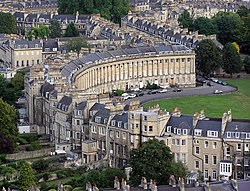The following is a timeline of the history of the city of Bath, Somerset, England.
Contents
- Prehistory
- 1st to 5th centuries
- 6th to 10th centuries
- 11th to 17th centuries
- 1700s
- 1800s
- 1900s
- 2000s
- Births
- See also
- References
- Bibliography
- Published in 18th century
- Published in 19th century
- Published in 20th century
- Published in 21st century
- External links
| History of England |
|---|
 |












